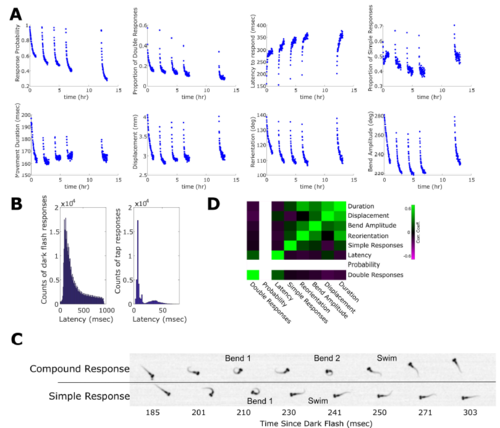Fig. S2
- ID
- ZDB-FIG-190729-3
- Publication
- Randlett et al., 2019 - Distributed Plasticity Drives Visual Habituation Learning in Larval Zebrafish
- Other Figures
- All Figure Page
- Back to All Figure Page
|
Habituation of dark flash response components. Related to Figures 2 and 3. A) Habituation is evident in 8 different components of the response, each dot represents the mean response to each stimulus (n=3120 larvae). B) Histograms of the distribution of latencies observed in response to dark flashes. n = 392161 responses in 3120 larvae (left). Histograms of the bimodal distribution of latencies observed in response to taps. n = 44515 responses in 3120 larvae (right). C) A “Compound Response” is defined as a movement where a large angle bend (Bend 1) is followed by a period of partial relaxation of the bend, before performing a second large angle bend (Bend 2). Finally, the larva fully relaxes and swims forward. In contrast, a “Simple Response” is characterized by a single large angle bend (Bend 1), which fully relaxes and the larva swims forward. C) Correlation matrix quantifying how correlated individual components of the dark flash response are in naïve larvae (Spearman’s Rho). The matrix is sorted as to match Figure 3D. Note that the “Probability” component can not be compared with the other components, since the remaining components can only be analyzed in conditions when a larva responds to the flash |

